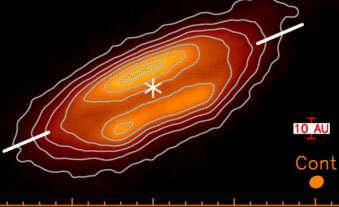An ALMA submiilimeter image of the dusty circumstellar disc around a young star. Astronomers are using ALMA polarization maps of the radiation from discs simialr to this one to infer the presence of a temperature gradient, and infer possible accretion onto the disc. (The asterisk marks the possible location of the embedded star; a scale of ten astronomical units is indicated.). Credit: Lee, Chin-Fei et al., 201
Polarized light is a familiar phenomenon because the scattering or reflection of light results in one of its two components being preferentially absorbed. The majority of sunlight on Earth, for example, is preferentially polarized due to scattering in the atmosphere (this helps make polarized sunglasses effective). Electromagnetic radiation from astrophysical sources can also be polarized, typically because of scattering from elongated dust grains that are aligned with each other by the local magnetic fields. These fields are thought to play a major, perhaps even a dominant role in controlling the shapes and motions of interstellar gas clouds and are extremely difficult to measure directly. Observations of polarization by dust grains offer a unique way to probe the magnetic fields.
The polarized emission from aligned grains in discs around young stellar objects is of particular interest to astronomers studying how planets develop and evolve in these discs. The polarized emission can reveal not only the details of the magnetic fields present but also (depending on the grain shapes and properties) other structural features of the disk environment, for example teh presence of anisotropic stellar radiation.
The ALMA submillimeter facility has recently had success detecting polarized emission from a number of young circumstellar discs. CfA astronomer Ian Stephens was a member of a team that used ALMA to observe the strength of such emission at multiple wavelengths. They conclude that magnetic field processes are unlikely to be the only mechanism at work, and they demonstrate that a temperature gradient across the disc can modify the polarized emission from aligned dust grains to more closely replicate observed data than the simple magnetic field models. The scientists' analysis of polarized dust emission in disks finds that the effects of a temperature gradient on polarization are strongest when a disc is viewed edge-on, and they validate their conclusion with detailed models. Because temperature gradients can be influenced by accretion onto the disk, these polarization results also provide a new method of probing disc accretion. Accretion heating, for example, can change the angle of the polarization with respect to the disc.
More information: Zhe-Yu Daniel Lin et al. Probing the temperature structure of optically thick discs using polarized emission of aligned grains, Monthly Notices of the Royal Astronomical Society (2020). DOI: 10.1093/mnras/staa542
Journal information: Monthly Notices of the Royal Astronomical Society
Provided by Harvard-Smithsonian Center for Astrophysics
























